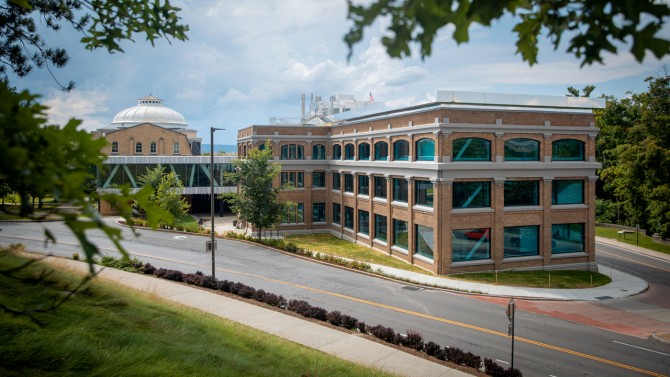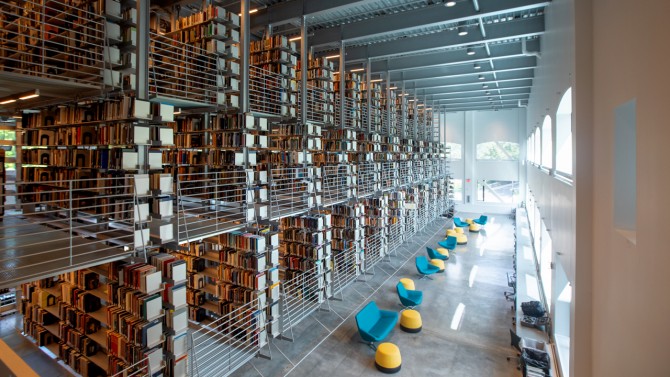Rand Hall has been transformed over the past 18 months to house the Mui Ho Fine Arts Library, a state-of-the-art facility on its top two floors with massed stacks of books as its centerpiece, digital resources, and voluminous reading and study space. Along with 8,000 square feet of shop space for the College of Architecture, Art and Planning occupying the first floor, the 107-year-old industrial building has been entirely rehabilitated.
New Mui Ho Fine Arts Library inspires by design
By Daniel Aloi
What sets the Mui Ho Fine Arts Library apart from other libraries is apparent in the sheer volume of the books it contains, visible all at once inside of Rand Hall.
The second and third floors of the renovated building are now a single open space, dominated by a rectangular mass of shelves and walkways, running almost the entire length of the space and suspended from the reinforced ceiling.
On those shelves are approximately 105,000 books, with room to grow. The three dense stack levels can hold up to 125,000 volumes, befitting one of the largest circulating academic collections in the Northeast dedicated to art and architecture.
“The books and their shelving form a sculptural whole, a breathtaking tribute to the potential of the printed word and image to inspire learning, research, creativity and innovation,” said Gerald R. Beasley, the Carl A. Kroch University Librarian.
The library also contains city and regional planning, landscape architecture and photography materials; periodicals, videos and other media. The total holdings of the fine arts collection, including those in the Library Annex, comprise more than 267,000 volumes and grow by about 4,000 titles each year.
Placing more of the collection in one location – a new state-of-the-art research library – was made possible by the adaptive reuse of Rand Hall and a gift of funding in 2013 from Mui Ho ’62, B.Arch. ’66, who worked there as a student.
The new library was designed by architect Wolfgang Tschapeller, M.Arch. ’87, whose goal for the project was “a 21st-century interpretation of the grand reading rooms associated with great research collections.” Whether viewed from inside or outside Rand, especially when illuminated at night, the design “is an immediate and quite physical invitation to discover an extraordinary collection,” Tschapeller said.
The library officially opened Aug. 5. It offers elevated views of the campus through Rand’s large windows from the open-ended mezzanine stacks. Seminar rooms and staff offices are tucked away and accessible from the stacks.
A help desk, combining reference and circulation services, can assist walk-in patrons; library staff can also retrieve materials from the shelves for patrons as needed.
The space houses an important sub-collection: hundreds of black-bound thesis volumes, lining the shelves beneath the bank of windows on the North Wall, a contribution to this literal body of knowledge by students in the College of Architecture, Art and Planning (AAP).
With the college’s fabrication facilities on the first floor, the finished library project represents “the full spectrum of media and material research coming together,” J. Meejin Yoon, B.Arch. ’95, the Gale and Ira Drukier Dean of AAP, said during a recent conversation in the new space.
“The hope is that this library will be used as an extension of the students’ network of spaces,” she said. “We wanted to make this building as porous as possible and connect directly to the studios and the Arts Quad. Having the stacks in a daylit space creates an open vertical living room for our students so they can find a place to study, find books, and really take this space on in a way that’s an extension of their work and study environment.”
As a truly collaborative environment, she said, “The library is not just for AAP, but for students across campus.”
The Kent Kleinman Book Stacks are named (with a gift from members of the AAP Dean’s Advisory Council) in honor of the dean of AAP from 2008 to 2018, who guided the Rand Hall project from planning through construction as part of the college’s multiyear facilities plan.
Collaborative study areas with movable soft seating line the space, along with individual study carrels and group workstations compatible with computers, phones and tablets. In addition to books, the library provides access to digital collections and online resources.
“New technologies will offer an equally important gateway to knowledge,” Beasley said. “In an intentional and playful contrast between two floating worlds – the physical world of books and journals and the weightless world of the internet – in this unique space, each derives added meaning from the other.”
The renovation project also rehabilitated the building envelope, improving Rand’s thermal and environmental performance, with a minimum expectation to meet LEED Silver certification standards. The roof of the building can also function as a flexible learning, social or experimental display space, with anchors for temporary structures, architecture projects and art installations.
Built in 1911, Rand Hall began life on campus as an engineering building, then for several decades housed student design studios and Department of Architecture faculty offices. The building also contained shop space for fabrication projects (such as architectural models and first-year architecture students’ Dragon Day designs).
When Milstein Hall opened in 2011, the Fine Arts Library moved from Sibley Dome and occupied part of Rand’s third floor. Books were stored in the Library Annex when construction on Rand began in December 2017.
This spring and summer, Library Annex staff did much of the pre-move preparation, and professional movers transported books from the Annex to Rand Hall. In deciding what to shelve in the new library, priority was given to high-demand titles that were not available electronically; periodicals less than five years old; and titles of specific interest to the AAP community.
The shops are now an expanded Material Practice Center taking up most (5,400 square feet) of the first floor, with laser cutters, 3D printers, lathes, band saws and more – “the tools for architects and artists to build and create,” Yoon said. “The tools range from industrial machinery and hand tools, to today’s most cutting-edge digital fabrication tools including CNC [computer numerically controlled] machines and robotics for construction.
“Having the library stacked on top of the fabrication facility,” she said, “showcases the production of one’s creative imagination – in essence, the production of new knowledge.”
Media Contact
Get Cornell news delivered right to your inbox.
Subscribe


